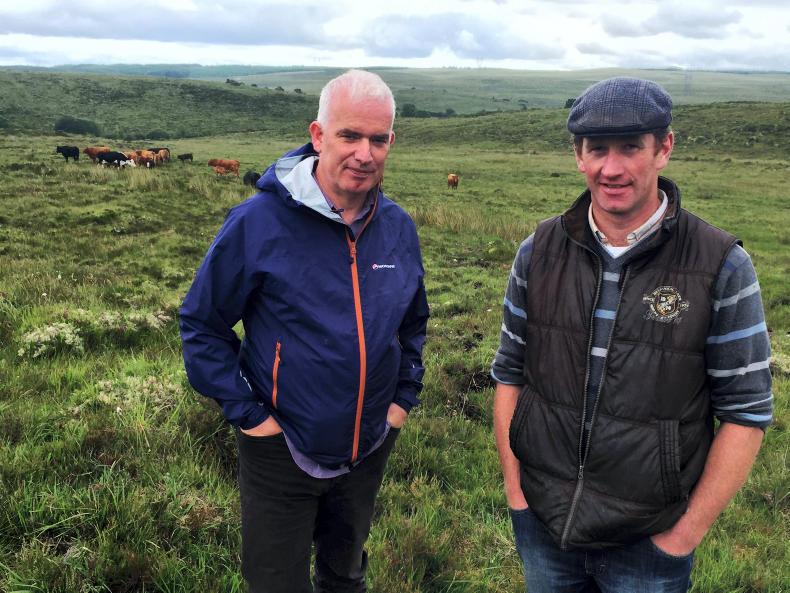At a meeting of the designated areas monitoring committee with the National Parks and Wildlife service on Thursday, farm organisations re-stated their position that there should be “no designation without compensation” for farmers. Padraic Joyce, who chairs the IFA’s project on special areas of conservation, pointed out that schemes existed until 2010 to support farmers with the restrictions imposed by nature conservation rules in areas such as the Shannon callows and hen harrier designated habitats.
ICSA rural development chairman Seamus Sherlock added that “the treatment of farmers with hen harrier status has been nothing short of a scandal, whereby farmers have waited many years without any scheme”.
I don’t think this is recognised enough
This is about to change. On the slopes of the Slieve Aughties in Derrybrien, Co Galway, Michael Cunningham’s 103ha suckler farm stretches across hilly pastures and boggy commonage. His land is 85% designated as a special protection area (SPA) for hen harriers and Michael is acutely aware of its environmental value. “A study showed that this peaty land has more carbon-reducing capacity than forestry. Moss and heather also reduce the risk of flooding. I don’t think this is recognised enough,” Michael said.
He is taking part in the development of the new locally-led Hen Harrier Scheme. On a recent visit to the farm, project manager Fergal Monaghan said: “The hen harrier is an indicator of the health of the ecosystems in these uplands. It is an open country bird and is dependent on farming to maintain its habitat. Farming in these areas supports biodiversity and carbon sequestration, and it can play a key role in reducing flood and wildfire risk. These are valuable outputs and we aim to give farmers an opportunity to share in this value.”
Fergal, a farm planner associated with a small team of scientists, accountants and conservationists, has won a six-year Department of Agriculture contract to deliver a €25m scheme for farmers in hen harrier designated areas. They are currently working with 12 farmers in six SPAs across nine counties, representing the various enterprises and the farm organisations collaborating with the project – IFA, INHFA, IFDL and ICMSA. Michael was nominated by the INHFA.
There are probably three or four nests on my farm, well hidden
“You wouldn’t see hen harriers every day,” Michael said. “When I’m herding in these hills I see them once or twice a week. There are probably three or four nests on my farm, well hidden.” Yet important signs can tell whether the birds will thrive on any piece of land, and this is what Fergal and his colleagues are working on.  He pointed to the benefits of the heather growth and low-stocking grazing on Michael’s farm, which leave none of the dead vegetation litter known to cause wildfires. Not only does this spare hen harriers’ nests – it also encourages their preys to thrive, such as the red grouse, ensuring food supply for the endangered species.
He pointed to the benefits of the heather growth and low-stocking grazing on Michael’s farm, which leave none of the dead vegetation litter known to cause wildfires. Not only does this spare hen harriers’ nests – it also encourages their preys to thrive, such as the red grouse, ensuring food supply for the endangered species.
Scoring system
The project’s ecologist has been developing a scoring system similar to the one used in the Burren programme: the better the habitat, the more points for the field and the higher the payment to the farmer. Fergal said participating farmers will not only receive money, but also information on how to improve the habitats on their farm and grow their payments. “You might have damage associated with supplementary feeding – by addressing this, you will be able to go up a score. It will be the farmer’s decision,” he said.
Fergal added that the project would identify issues affecting farmers’ ability to maintain both hen harrier-friendly fields and viable farms. If insufficient water supply or access prevents good habitat maintenance, then payments will be available for water troughs or fencing, and this may benefit economic performance as well. “There is no contradiction between agricultural and environmental goals,” said Fergal.

One challenge is that the project cannot fund actions already supported by other schemes. Michael participates in GLAS+, which means he has reduced silage cutting and topping, in turn lowering his stock numbers. His rush control options are also limited. He says the extra payment and the income loss more or less even out. The new hen harrier scheme cannot support any of these existing actions and the project team will have to work around this.
We can’t develop the project on a computer at a desk
They are currently conducting around 30 local meetings with farmers in all SPAs to discuss the results of their experiments with assessments, scoring, payments and improvement plans on the 12 development farms. “We can’t develop the project on a computer at a desk,” Fergal said. The scheme is then due to open by the end of the year. While he is inspired by the model and the success of the Burren programme, Fergal is also aware of the challenge ahead: “They had 15 years to reach 500 farmers, we have four months,” he said. There are around 4,000 farmers in designated hen harrier areas.
As for Michael, he is convinced that this approach will become the norm as Ireland comes under international pressure to improve environmental standards. “This is the way of farming in the future,” he said.
New hen harrier scheme targets opening date this year
